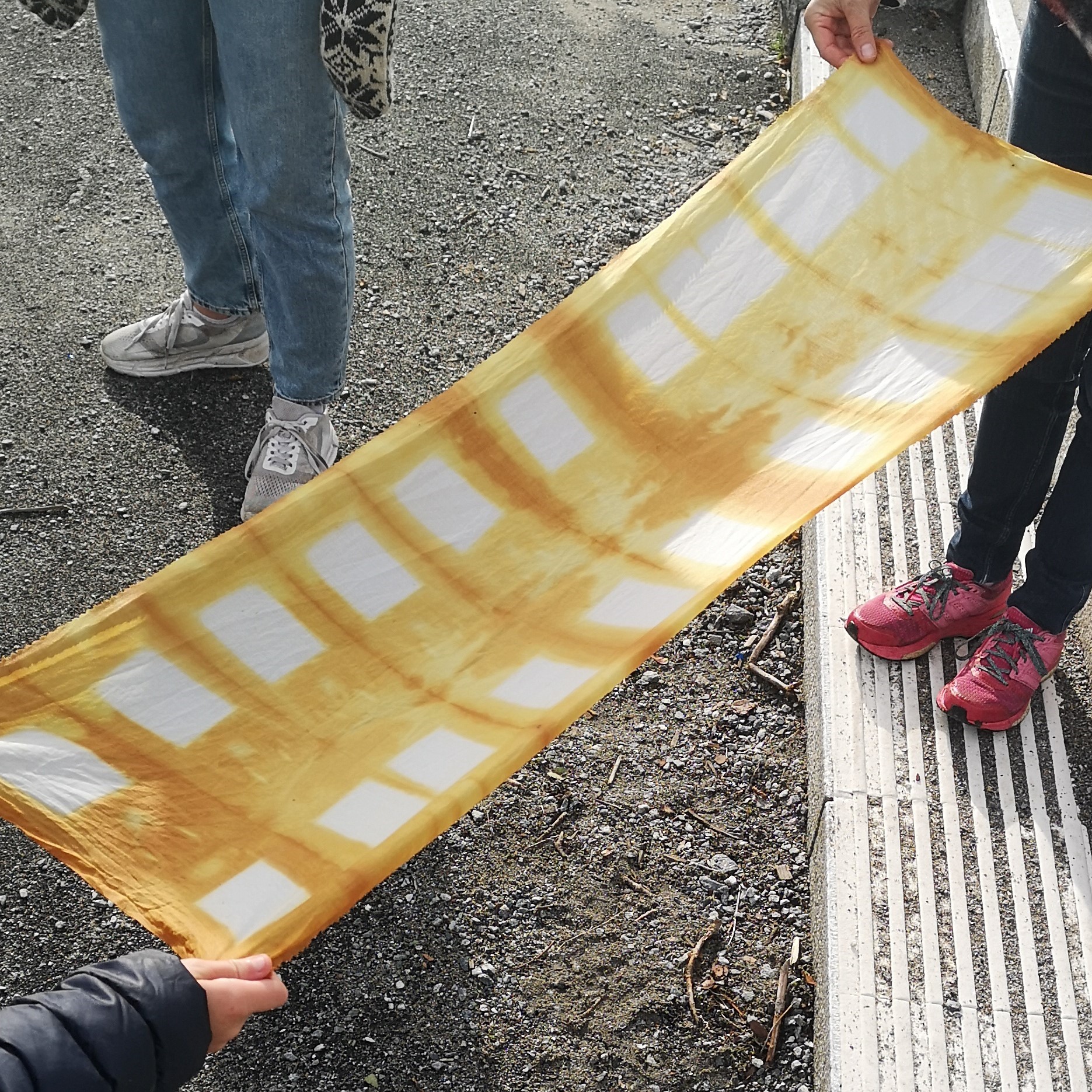Shibori her og nå
Et kunstprosjekt med naturmaterialer i skolen
DOI:
https://doi.org/10.7577/formakademisk.4896Emneord (Nøkkelord):
Shibori, tverrestetisk kunstformidling, bærekraft, poststrukturalisme, posthumane teorierSammendrag
I denne teksten tar jeg utgangspunkt i et skoleprosjekt med den eldgamle japansk innfargingsteknikken shibori. Prosjektet er motivert av en kritikk av den antropocen perioden vi lever i. Spørsmålet som drøftes er i hvilken grad et slikt kunstprosjekt med naturmaterialer kan bidra til økt bevissthet om menneskeskapte miljøproblemer. Jeg betrakter ikke verden utenfra eller som noe i stagnasjon, men snarere som en verden i bevegelse og anser dens tilblivelse som vårt ansvar. Naturmaterialer anses ikke bare som ressurser underordnet menneskes behov, men de inngår i et sårbart samspill mellom de som bebor verden. Vi mennesker har ansvar for hvordan verden utvikler seg, og en slik bevissthet kan etableres hos kommende generasjoner.
Referanser
Angelo, E., & Karlsen, S. (Red.) (2014). Kunstner eller lærer? Profesjonsdilemmaer i musikk- og kunstpedagogisk utdanning. Cappelen Damm Akademisk.
Anundsen, T. W. & Illeris, H. (2019). Inhabiting practice: performative approaches to education and research as art. Routledge. https://doi.org/10.4324/9780429444159-9
Arai, M & Wada, Y. I. (2010). Beni itajime: carved broad clam resist dying in red. Textile Society of America Symposium Proceedings. 5. https://digitalcommons.unl.edu/tsaconf/5/ https://digitalcommons.unl.edu/cgi/viewcontent.cgi?article=1004&context=tsaconf
Atkinson, D. (2015). The adventure of pedagogy, learning and the not-known. Subjectivity, 8(1), 43–56. https://doi.org/10.1057/sub.2014.22
Auestad, R. A. (2021). Haiku. I Store norsk leksikon. https://snl.no/haiku
Aure, V. (2013). Didaktikk – i spennet mellom klassisk formidling og performative praksis. Nordic Journal of Art and Research, 2(1), 1-24. https://doi.org/10.7577/if.v2i1.611
Barad, K. (2003). Posthumanist performativity: Toward an Understanding of How Matter Comes to Matter. Signs: Journal of women in culture and society, 28(3), 801-831. https://doi.org/10.1086/345321
Barad, K. (2007). Meeting the universe halfway. Quantum physics and the entanglement of matter and meaning. Duke University Press. https://doi.org/10.2307/j.ctv12101zq
Bourriaud, N. (1998). Esthétique relationnelle. Les presses du réel.
Bourriaud, N. (2007). Relasjonell estetikk (B. Christensen-Scheel, Overs.). Pax Forlag. (Opprinnelig utgitt 1998)
Deleuze G. & Guattari F. (1980). Capitalisme et schizophrénie 2: Mille plateaux. Les éditions de minuit.
Dewey, J. (2005). Art as experience. Berkley Publishing Group.
Diouri, A. (2020). Art, Borders, and Boundaries (The 1952 Black Mountain College Event). In K. Amine, & J. Akabli (red.) Across Borders and Thresholds. Performing in Zones of Contact and Friction. Publications of the Faculty of Letters and Human Science at Abdelmalek Essaadi University – Tétouan & the International Center for Perfromance Studies – Tangier – Morcco (Series colloquia and conferences). Volk Edition.
Dolphijn, R. & van der Tuin, I. (2012). New Materialism: Interviews & Cartographies. Open Humanities Press. https://doi.org/10.3998/ohp.11515701.0001.001
Gardner, H. (2011). Frames of mind: the theory of multiple intelligences. Basic Books.
Hansson, H. (2016). En barnehage til begjær. Å gi form til barnehagens innhold. Fagbokforlaget.
Hernes, L. (2014). Pedagogen og den kunstneriske prosessen. In Angelo, E. & Karlsen, S. (Eds.) Kunstner eller lærer? Profesjonsdilemmaer i musikk- og kunstpedagogisk utdanning. (s. 205-217). Cappelen Damm Akademisk.
House of Wandering Silk. (u.å). Itajime Shibori. Our artisans & process. https://www.wanderingsilk.org/itajime-shibori-artisans-process
Hultman K. & Lenz Taguchu, H. (2010). Challenging anthropocentric analysis of visual data: a relational materialist methodological approach to educational research. Internal Journal of Qualitative Studies in Education, 23(5), 525-542, https://www.tandfonline.com/doi/full/10.1080/09518398.2010.500628
Idsøe, E. M. C. (2019). Om transdisiplinaritet som redskap i møte med store utfordringer. https://www.fpol.no/om-transdisiplinaritet-som-redskap-i-motet-med-store-utfordringer/
Irwin, R. & Springgay, S. (2008). A/r/tography as practice-based research. In M. Cahnmann-Taylor & R. Siegesmund (Eds.) Arts-based Research in Education. Foundations for practice. (s. 103-124). Routledge.
Jamouchi, S. (2019). Exploring art and craft in teacher education whilst going toward a performative approach: Some reflections on re-turning and engaging diffractively with felting wool. Simon Fraser University Educational Review, 12(1). https://doi.org/10.21810/sfuer.v12i1.612
Jamouchi, S. (2020). Unfolding aspects of affective togetherness. Building relations through a performative approach to art education. Matter. Journal of New Materialism Research, 1(2). https://doi.org/10.1344/jnmr.v1i2.31840
Klungland, M. (2021). Materiell-kollektive praksis. En tilnærming til fagdidaktikk for kunst og håndverk utviklet I veveprosjektet: Veve I åpne dører. [PhD avhandling, Universitet i Agder]. https://hdl.handle.net/11250/2756839
Kunnskapsdepartementet. (2017). Verdier og prinsipper for grunnskoleopplæringen – overordnet del av læreplanverket. Fastsatt som forskrift ved kongelig resolusjon. Læreplanverket for Kunnskapsløftet 2020. https://www.regjeringen.no/no/dokumenter/verdier-og-prinsipper-for-grunnopplaringen/id2570003/
Kunnskapsdepartementet. (2020). Læreplan i kunst og håndverk (KHV01-02). Fastsatt som forskrift. Læreplanverket for Kunnskapsløftet 2020. https://www.udir.no/lk20/khv01-02
Kurimanzutto. (2022). https://www.kurimanzutto.com/artists/rirkrit-tiravanija
Løvlie, L. (2013). John Dewey. Danning til demokrati. I I. S. Straume (Red.) Danningens filosofihistorie (s. 252-263). Oslo: Gyldendal Akademisk.
National Geographic Society (2022). Anthropocene. https://education.nationalgeographic.org/resource/anthropocene
Skregelid, L. (2021). Dissensuality and affect in Education. International Journal of Art & Design Education, 40(4). 690-701. https://doi.org/10.1111/jade.12381
Springgay, S. & Zaliwska, Z. (2017). Lerning to be affected: Matters of pedagogy in the artists’ soup kitchen. Educational Philosophy and Theory, 49(3), 273-283. https://doi.org/10.1080/00131857.2016.1216385
Tenthouse. (2021). About. https://www.tenthaus.no/about/
World Shibori Network. (2023). Welcome to World Shibori Network Foundation. https://shibori.org/
Østern, T. P. (2014). Den skapende og undervisende dansekunstneren. I E. Angelo, & S. Karlsen, S. (Eds.) Kunstner eller lærer? Profesjonsdilemmaer i musikk- og kunstpedagogisk utdanning (s. 205-217). Cappelen Damm Akademisk.
Aarnes, H. (2021). Rhizome. I Store norsk leksikon. https://snl.no/rhizom

Nedlastinger
Publisert
Hvordan referere
Utgave
Seksjon
Lisens
Opphavsrett 2023 Samira Jamouchi

Dette verket er lisensiert under Creative Commons Attribution-NoDerivatives 4.0 International License.
- Forfatteren(e) beholder sin opphavs- og kopieringsrett til eget manuskript, men gir tidsskriftet varig rett til 1) å fremføre manuskriptet for offentligheten i den opprinnelig publiserte digitale form, og 2) å registreres og siteres som første publisering av manuskriptet.
- Forfatteren må selv forvalte sine økonomiske kopieringsrettigheter overfor eventuell tredjepart.
- Tidsskriftet gir ingen økonomisk eller annen kompensasjon for innsendte bidrag, medmindre det er gjort særskilt avtale om dette med forfatteren(e).
- Tidsskriftet plikter å arkivere manuskriptet (inklusive metadata) i den opprinnelig publiserte digitale form, i minst ett dertil egnet åpent tilgjengelig langtidsarkiv for digitalt materiell, som for eksempel i de norske universitetenes institusjonsarkiv innen rammen av NORA-samarbeidet.
Verket vil bli publisert OpenAccess med en Creative Commons 4.0-lisens som tillater alle å lese, dele og tilpasse innholdet, også kommersielt, under lisensvilkårene:
Dette verket må tilskrives/ krediteres på riktig måte, en lenke må gis til CC-BY 4.0-lisensen, og endringer som er gjort må angis på en rimelig måte, men ikke på noen måte som antyder at lisensgiveren støtter deg eller din bruk.



